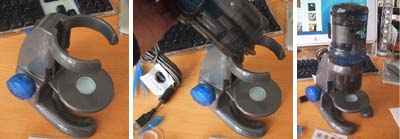

The image is interpolated to 512x384 pixel resolution for display in the Microscope software's Live View window. CIF resolution is 352x288 pixels, but the microscope software only uses a central region of interest (ROI) of the image - 320x240 pixels to be exact. The microscope used a CMOS CIF sensor - ideal for use in a microscope that focuses on a small image area. The microscope came with software that enabled the user to snap images, make time lapse movies, import and export images, lighting control, and image effects and titling. The microscope could be removed from its base stand allowing it to be used as a hand-held microscope. It featured 10x/60x/200x lenses and had both upper and lower adjustable lighting and focus height adjustment. The QX3 microscope connected easily to a Windows based PC via it's USB cable which also powered the microscope and its lighting. Having a $100 price point, this electronic video toy was Intel's attempt at entering the science education market using optics, digital imaging, and the latest computer technology at the time. The Intel Play QX3 Computer Microscope was developed as the result of a creative partnership between computer chip giant Intel and the innovative toy designer Mattel.


How to use the Intel Play & other USB Digital Microscopes


 0 kommentar(er)
0 kommentar(er)
